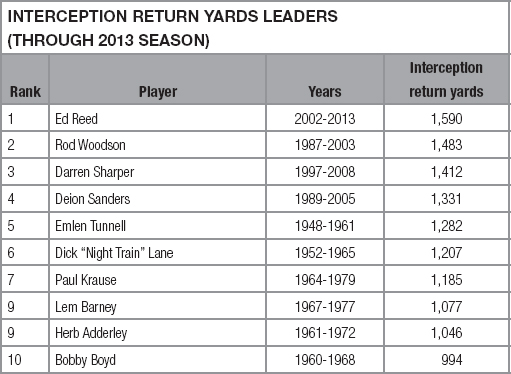
#49
ROD WOODSON
There was no doubt from the moment he stepped on an NFL field that Rod Woodson was going to do his job.
Woodson, however, had many jobs. The first of which was shutting down opposing receivers. He could play physically at the line of scrimmage or he could play the trail technique and goad a quarterback into thinking the receiver was open, throwing the pass so Woodson could then intercept it. He could also play straight coverage, handle multiple moves, and stay with the receiver step for step.
Woodson didn’t stop there, though. He was a first-rate tackler in the running game and one of the top kick returners of his era. After a long run as an All-Pro cornerback, Woodson switched to safety and closed out his career there. In addition to being one of the best cornerbacks the game has known, Woodson was also one of the best safeties.
In his 17 NFL seasons with the Pittsburgh Steelers (1987–1996), San Francisco 49ers (1997), Baltimore Ravens (1998–2001), and Oakland Raiders (2002–2003) Woodson recorded 71 interceptions (third all-time), 1,483 interception return yards (first all-time), 2,362 punt return yards, and 17 non-offensive touchdowns (second all-time). He also reached the end zone on an NFL-record 12 interception returns (first all-time), one fumble return, two punt returns, and two kickoff returns. Woodson, a member of the 1990s All-Decade Team, was named to the Pro Bowl 11 times (a record for defensive backs) and in 1994—after just seven years as an NFL corner—was one of just five active players to be named to the NFL’s 75th Anniversary Team. The others were Jerry Rice, Joe Montana, Reggie White, and Ronnie Lott.
The 10th overall pick in the 1987 NFL Draft (out of Purdue University), Woodson enjoyed the fact that he came of age in the NFL when pass coverage was far more physical than it is today. In the rare event that he was beaten for a few steps, Woodson was not averse to putting his hands on a receiver. “If they ran by you, you could push them and slow ’em up, so how could you ever get beat deep?” he asked. “Wouldn’t that be fun? You could terrify receivers.”
But as the years went by and defensive backs faced more and more restrictions, Woodson made every adjustment he needed to and rarely lost any of his battles. He set a tone for the Steelers (and later on for the 49ers, Ravens, and Raiders) that his teammates took note of.
“It’s crazy,” said Steelers cornerback D.J. Johnson in 1994. “You can’t touch a receiver or it’s a flag, and they can do anything they want to get open. You have to depend on a great pass rush and some liberal referees. For Rod to do what he is doing, it is simply spectacular. How can you guard a guy that close, tip the ball, or make an interception on every play and not be called for a penalty? It just takes outstanding athletic ability.”
After Woodson made back-to-back Pro Bowls in 1992 and 1993, opponents started to recognize his ability to make plays and started scheming against him. They refrained from throwing to his side of the field for fear that he would intercept the ball or force a fumble. Steelers head coach Bill Cowher changed Woodson’s role and made him a hybrid cornerback/safety so he could find the ball and make plays even if the receiver he was covering was not involved in the play.
Cowher’s instructions were not necessarily specific. He just told Woodson in his inimitable jaw-jutting, spit-flying style that he needed to find the ball and make plays. “He kind of thrives on that and has taken his game to another level,” Cowher said. “You have to try to get him around the football as much as you can. If you leave him in one spot, they can scheme away from him. We want him involved.”
Woodson said that when he came into his own with the Steelers, it was the combination of his experience, athletic ability, and the coaching of defensive coordinator Dick LeBeau that turned him into one of the best all-around defensive players the game has ever seen. “Coach LeBeau was such a stickler for technique,” Woodson said. “He knew what we needed to do and he excelled at teaching us. We did it the right way. We played our system and kept up all our responsibilities. We stayed on the outside shoulder of the receiver, and we didn’t freelance.”
Woodson would have had a memorable career if it ended during the 1995 season, when an anterior-cruciate-ligament injury sidelined him and threatened the end of his playing days. He did not have the same quickness when he came back but he moved to free safety and became one of the best at that position when he played with the 49ers, Ravens, and Raiders.
His most memorable season during that second portion of his career came in 2000, his third season with the Ravens. That year, Baltimore won the championship with the best defense the league had seen since the 1985 Bears. Middle linebacker Ray Lewis was in the prime of his career and clearly the unit’s best player and leader, but Lewis was one of the first to acknowledge how much Woodson meant to the team at free safety. Woodson’s 77 tackles, two forced fumbles, three fumble recoveries, and four interceptions gave Baltimore’s sack-oriented and hard-charging defense the confidence that if the pass rushers didn’t get to the quarterback, Woodson would make the play in the secondary.
He would play three more years and make one more All-Pro team in 2002 and then call it a career. He was a dominant player in the beginning, the middle, and the end. Before knee surgery and after. One of a kind.
